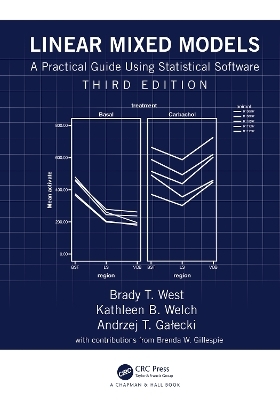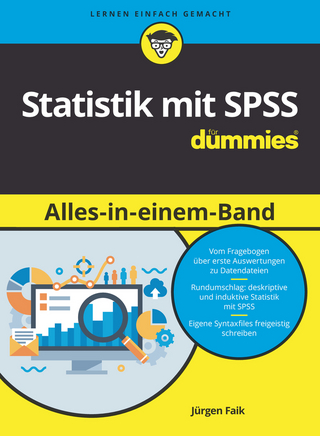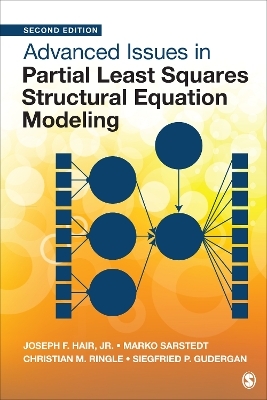
Linear Mixed Models
Chapman & Hall/CRC (Verlag)
978-1-032-01932-1 (ISBN)
Highly recommended by JASA, Technometrics, and other leading statistical journals, the first two editions of this bestseller showed how to easily perform complex linear mixed model (LMM) analyses via a variety of software programs. Linear Mixed Models: A Practical Guide Using Statistical Software, Third Edition continues to lead readers step-by-step through the process of fitting LMMs.
The third edition provides a comprehensive update of the available tools for fitting linear mixed-effects models in the newest versions of SAS, SPSS, R, Stata, and HLM. All examples have been updated, with a focus on new tools for visualization of results and interpretation. New conceptual and theoretical developments in mixed-effects modeling have been included, and there is a new chapter on power analysis for mixed-effects models.
Features:•Dedicates an entire chapter to the key theories underlying LMMs for clustered, longitudinal, and repeated measures data
•Provides descriptions, explanations, and examples of software code necessary to fit LMMs in SAS, SPSS, R, Stata, and HLM
•Contains detailed tables of estimates and results, allowing for easy comparisons across software procedures
•Presents step-by-step analyses of real-world data sets that arise from a variety of research settings and study designs, including hypothesis testing, interpretation of results, and model diagnostics
•Integrates software code in each chapter to compare the relative advantages and disadvantages of each package
•Supplemented by a website with software code, datasets, additional documents, and updates
Ideal for anyone who uses software for statistical modeling, this book eliminates the need to read multiple software-specific texts by covering the most popular software programs for fitting LMMs in one handy guide. The authors illustrate the models and methods through real-world examples that enable comparisons of model-fitting options and results across the software procedures.
Brady T. West is a research professor in the Survey Methodology Program, located within the Survey Research Center at the Institute for Social Research (ISR) on the University of Michigan-Ann Arbor (U-M) campus. He earned his PhD from the Michigan Program in Survey and Data Science (formerly the Michigan Program in Survey Methodology) in 2011. Before that, he received an MA in Applied Statistics from the U-M Statistics Department in 2002, being recognized as an Outstanding First-year Applied Masters student, and a BS in Statistics with Highest Honors and Highest Distinction from the U-M Statistics Department in 2001. His current research interests include total survey error / total data quality, responsive and adaptive survey design, interviewer effects, survey paradata, the analysis of complex sample survey data, and multilevel regression models for clustered and longitudinal data. He has developed short courses on statistical analysis using SAS, SPSS, R, Stata, and HLM, and regularly consults on the use of procedures in these software packages for the analysis of longitudinal and clustered data. The author or co-author of more than 180 peer-reviewed publications and three edited volumes on survey methodology, he is also a co-author of a book entitled Applied Survey Data Analysis (with Steven Heeringa and Patricia Berglund), the second edition of which was published by Chapman Hall in 2017. He lives in Dexter, Michigan with his wife Laura, his son Carter, and his daughter Everleigh. Kathy Welch is a retired former senior statistician and statistical software consultant at CSCAR (Consulting for Statistics, Computing & Analytics Research) at the University of Michigan, Ann Arbor. She received a B.A. in sociology (1969), an M.P.H. in epidemiology and health education (1975), and an M.S. in biostatistics (1984) from the University of Michigan (UM). During her career, she regularly consulted on the use of SAS, SPSS, Stata, and HLM for analysis of clustered and longitudinal data, taught a course on statistical software packages in the University of Michigan Department of Biostatistics, and taught short courses on SAS software. She also co-developed and co-taught a course on analysis of data from clustered and longitudinal studies at the School of Public Health at the University of Michigan. Andrzej Galecki is a research professor in the Division of Geriatric Medicine, Department of Internal Medicine, and Institute of Gerontology at the University of Michigan Medical School, and in the Department of Biostatistics at the University of Michigan School of Public Health. He received a M.Sc. in applied mathematics (1977) from the Technical University of Warsaw, Poland, and an M.D. (1981) from the Medical Academy of Warsaw. In 1985 he earned a Ph.D. in epidemiology from the Institute of Mother and Child Care in Warsaw (Poland). Since 1990, Dr. Galecki has collaborated with researchers in gerontology and geriatrics. His research interests lie in the development and application of statistical methods for analyzing correlated and over-dispersed data. He developed the SAS macro NLMEM for nonlinear mixed-effects models, specified as a solution of ordinary differential equations. His research (Galecki, 1994) on a general class of covariance structures for two or more within-subject factors is considered to be one of the very first approaches to the joint modeling of multiple outcomes. Examples of these structures have been implemented in SAS proc mixed and the MIXED command in SPSS. In 2015 he was selected as a Fellow of the American Statistical Association. He is also a co-author of more than 120 publications. Brenda Gillespie is the associate director of CSCAR (Consulting for Statistics, Computing & Analytics Research) and a research associate professor of Biostatistics at the University of Michigan, Ann Arbor. She received an A.B. in mathematics (1972) from Earlham College in Richmond, Indiana, an M.S. in statistics (1975) from The Ohio State University, and earned a Ph.D. in statistics (1989) from Temple University in Philadelphia, Pennsylvania. Dr. Gillespie has collaborated extensively with researchers in health-related fields, and has worked with mixed models as the primary statistician on the Collaborative Initial Glaucoma Treatment Study (CIGTS), the Dialysis Outcomes Practice Pattern Study (DOPPS), the Scientific Registry of Transplant Recipients (SRTR), the University of Michigan Dioxin Study, and at the Complementary and Alternative Medicine Research Center at the University of Michigan.
1. Introduction
2. Linear Mixed Models: An Overview
3. Two-Level Models for Clustered Data: The Rat Pup Example
4. Three-Level Models for Clustered Data
5. Models for Repeated-Measures Data: The Rat Brain Example
6. Random Coe□cient Models for Longitudinal Data: The Autism Example
7. Models for Clustered Longitudinal Data: The Dental Veneer Example
8. Models for Data with Crossed Random Factors: The SAT Score Example
9. Power Analysis and Sample Size Calculations for Linear Mixed Models
A. Statistical Software Resources
B. Calculation of the Marginal Covariance Matrix
C. Acronyms / Abbreviations
| Erscheinungsdatum | 13.06.2022 |
|---|---|
| Zusatzinfo | 48 Tables, black and white; 64 Line drawings, black and white; 64 Illustrations, black and white |
| Sprache | englisch |
| Maße | 178 x 254 mm |
| Gewicht | 2150 g |
| Themenwelt | Mathematik / Informatik ► Mathematik ► Computerprogramme / Computeralgebra |
| Naturwissenschaften ► Biologie | |
| ISBN-10 | 1-032-01932-8 / 1032019328 |
| ISBN-13 | 978-1-032-01932-1 / 9781032019321 |
| Zustand | Neuware |
| Haben Sie eine Frage zum Produkt? |
aus dem Bereich


